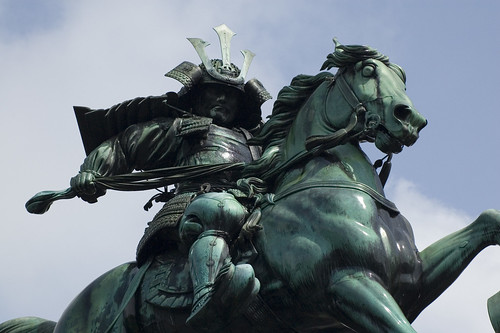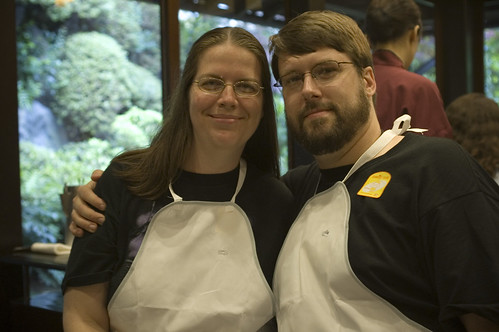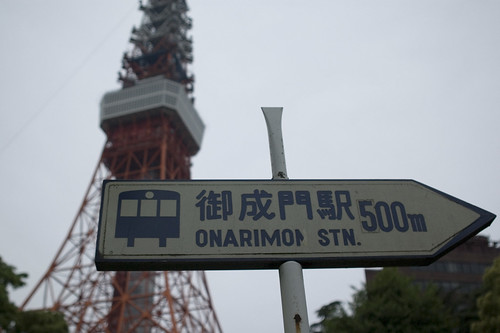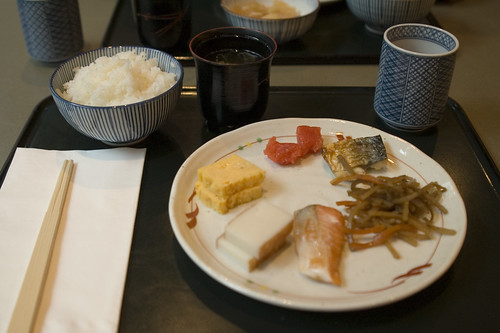When we last left off the trip narrative, Aaron and I had just finished an overpriced breakfast buffet and were preparing to embark on the Dynamic Tokyo Tour: a nine-hour whirlwind bus tour of Tokyo, taking us to lunch, a tea ceremony, gardens, the Imperial Palace, and more.
As we sat in the hotel lobby with both of our jackets, my camera, and Aaron’s shoulder bag, waiting for the bus, we noticed that other gaijin were joining us at a distance. Two couples were talking about their impending day-tour of Mt. Fuji, so we knew they’d be on some tour, but not ours.
Eventually, we went outside to wait for the bus — once it arrived, a Sunrise Tours representative got off the bus, asked if we were waiting for the tour, and presented us with a colored slip of paper bearing our names and the tour we were going on. Then all of the tour-awaiting gaijin boarded the bus with us, and it was explained to us that we would trade in our colored slip of paper at Hamamatsucho Bus Station for a printed ticket. Once we arrived at Hamamatsucho, that’s exactly what happened. We presented our blue piece of paper and received a large printout in return. The nice lady behind the counter explained our tickets to us, told us at which gate our bus would be arriving, and pointed us in the right direction.
 As we waited for our tour bus to arrive, we not only saw our first glimpse of vending machine goodness (which another gaijin was also photographing, so I was less shy about it myself), but we also got talking to a nice seemingly-Japanese man who said he was visiting from Australia. Small talk, but it was the first real conversation we’d had with someone other than each other since our arrival. Funny guy.
As we waited for our tour bus to arrive, we not only saw our first glimpse of vending machine goodness (which another gaijin was also photographing, so I was less shy about it myself), but we also got talking to a nice seemingly-Japanese man who said he was visiting from Australia. Small talk, but it was the first real conversation we’d had with someone other than each other since our arrival. Funny guy.
We traded in part of our giant-ass ticket printouts for bright yellow stickers, which were to act as tickets to particular places, in addition to keeping us all wrangled together. As we did this, the woman who took our tickets (who turned out to be our tour guide) informed us that we would be eating beef and pork at our Japanese barbecue lunch, and confirmed that this was OK with us. (It was, of course — we’ll eat just about anything. Although we did hear that sea urchin is pretty vile… we didn’t try any while we were there, nor did we try natto.)
After that, no problem. Bus arrived, we boarded, and we were off to the Tokyo Tower.
The Tokyo Tower (in case you haven’t figured it out from previous photos) is a replica of the Eiffel Tower. It was built in the 1950s, and it stands 333 meters tall. Our magic yellow stickers got us up to the mid-level observation deck; it was trying to rain, though, so we couldn’t see much. We opted to go in front of our tour guide, Junko (“Just remember ‘junk’ with an ‘o’ on the end!”) and do our own sightseeing. Usually, Fuji-san is visible from the Tokyo Tower, but not that day. We did see our hotel, which was right across the street, and a couple pretty neat views of the city.
There’s also a crapload of souvenir shops, eateries, and general touristy stuff at the Tower. We walked by the Sanrio shop, but didn’t get the opportunity to really buy much at the Tokyo Tower until later on in our vacation. (It was right next door, after all, so no big loss there.)
Next on the tour: Happo-en Garden.
At Happo-en, we broke into two groups: one group watched a tea ceremony, then got time to visit the grounds, while the other group got to see the grounds first, before their tea ceremony. Aaron and I were the last two to make it into the first group. As such, we ended up sitting not on the bench surrounding the table in the tea house, but on small wooden and canvas stools, instead. Turns out that I got the best seat in the house for photographing the tea ceremony.

The tea, it was explained, is actually dried and powdered green tea. It’s much stronger and more bitter than brewed tea, and is served with small sweets beforehand. The sweets we received were sugary confections in the shape of a green maple leaf and a purple hydrangea. I’m ill-suited to explain the entire ceremony and the significance of everything therein, but the Tea Master basically checks all the bowls and utensils for purity and quality, ritualistically cleans and wipes them, then prepares the tea with a combination of boiling water and cooler water, so as not to destroy all the nutrients and flavor in the tea.
At this point in the ceremony, an assistant came out of the back of the tea house, carrying two trays of prepared bowls of tea. They were passed out to each of us, set carefully on the table in front of us with the decorative pattern on the bowl facing us. This was so we could contemplate and admire the loveliness of the artwork, which was truly very classic and simple. Then we held the bowl in our left hand and turned the bowl with our right (yes, just like the tea ceremony in Karate Kid II), because you don’t want to sully the side of the bowl that has the design on it. We all took one small sip, and the Tea Master (the woman who prepared the tea) asked us something in Japanese.
We’d been primed for this en route by Junko. She told us that the Tea Master would ask us how the tea was. Even if we didn’t like it, we were required to say kekko desu, which I’d learned from my Pimsleur lessons means “it’s fine,” or “all right.” (What Pimsleur didn’t tell me, though, is that kekko desu is apparently an older phrase, not often used in normal society these days. I wonder what kinds of looks I would have gotten, had I used it…)
As a learning aid, Junko had a notebook in which she had written the words in giant letters: KEKKO DESU. Then, on the next page, she wrote: KATE CALL THIS. If we couldn’t remember kekko desu, we were to remember “Kate call this,” or just say “Kate” and mumble the rest. As for some other helpful Japanese, she had written out arigato gozaimasu, or “thank you,” then on the next page GO THY MUST. She also drew a nice picture of an alligator and told us to remember “alligator” without the “r”. Priceless. Simply priceless.
Back to the ceremony. When the Tea Master asked how we liked the tea, we all obediently chorused, “Kekko desu.” We were then directed to drain our bowls of tea, and to make an appreciative slurping noise at the end. We then each took our thumb and forefinger and wiped off the place on the bowl where our lips had touched, then wiped our fingers on the paper on which the sweets had been served. Then we turned the bowl back around to admire the pattern again before setting the bowl back down on the table. The ceremony was over, and we all left the tea house to admire the scenery.

Happo-en Garden has a collection of bonsai trees ranging from a few decades to a few hundred years old. They also have a pond with multicolored carp, and some beautiful flower gardens. We definitely could have spent a longer time here just enjoying the views and walking the grounds, but we had a date to keep at Chinzanso Gardens for a Japanese barbecue lunch at Mokushun-do Restaurant.
Previous – Day 2, Part 1: Breakfast | Next – Day 2, Part 3: Japanese BBQ


 As we waited for our tour bus to arrive, we not only saw our first glimpse of
As we waited for our tour bus to arrive, we not only saw our first glimpse of 


